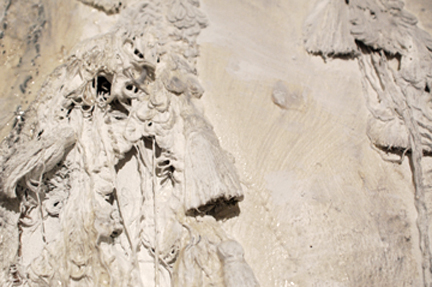
"Attached #3" (Detail) Kimber Shiroma 2007
Kimber Shiroma's latest exhibit, "Entropy and Emergence" is an intriguing show to check out this month at the artist's collective Gallery 114. This new work of Shiroma's is ambitious and experimentally thorough as the artist attempts to mold breath and symbolism into a mishmash of materials that run the gamut of malleability. Shiroma employs everything from photographs to baby powder in order to birth these beasts, and they are indeed, a lot to swallow. This body of new work is a continuation of Shiroma's departure from previous work which involved grids of various sourced images, which referenced pop culture, the body, and the push and pull in the tenuous boundaries between order and chaos. These earlier pieces were all very much controlled and appeared to be rather calculated constructions. The more pliable materials she employs here allow Shiroma to hint at similar subject matter with a different voice.
Upon entering the space, Shiroma's massive works hang disjointedly, like pensive and ominous herbivores, confronting the viewer in a vast yet awkward richness. The pieces that demand immediate attention are of course the two biggest paintings confronting the viewer immediately upon entering: "Attached #2" and "Attached #3".
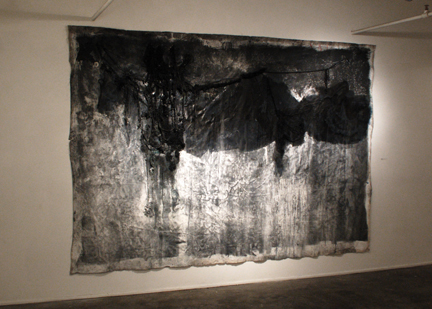
"Attached #2" Kimber Shiroma 2007
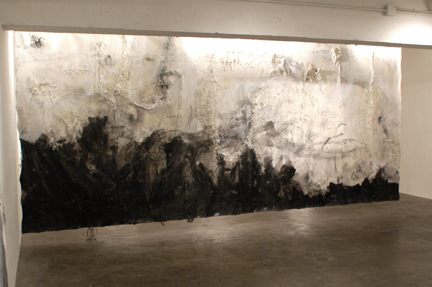
"Attached #3" Kimber Shiroma 2007
These paintings suggest tortured landscapes fashioned from powdered skin whose minions of warriors and tired pilgrims seem to travel over and through and almost off their textured battlegrounds. The references these big pieces pulse with is extensive, and it is necessary to sit with them to digest all they confront and suggest. Chinese landscapes, specifically Francisco de Goya's "San Isidro Pilgrimage",

"A Pilgrimage to San Isidro" Francisco De Goya 1820-23
and the calligraphic myths of Cy Twombly run amok in the midst of what appear to be fossilized tassels and the guts of mystics. The German painter and political artist Anselm Kiefer mildly comes to mind in terms of the gritty aesthetics of these paintings, yet Shiroma's work differs entirely in its lack of historical subject matter. The presence of these two works is confrontational and daunting. Shiroma toys with the physical limits of what these materials are capable of within this context, warping them, ripping them, drowning them in opposites. There is a monastic transcendence to work like this: as if the toil of the making opened doors to the metaphysical. There is also something filmic about these pieces; the eye moves across them with initial linearity, as in reading, yet then begins to dart back and forth across the surface with what feels like animalistic abandon. Certain bits of shine and pomp and then the foiling receding of space in darkness or subtlety add dimensions of space and time. They become old 16 milimeter movies being projected onto impromptu movie screens. Here is their romance and nostalgia. Overexposed and melted, almost images surface within the edges of the screen. These are Shiroma's beginnings of the push she will take to materiality, and it is an intrigue to wonder to what distance she will take them.
Unfortunately, the space of Gallery 114 enormously dilutes the power of these pieces. The way in which they respectively must be lit detracts from what could be an operatic reception of these requiem-esque monsters, and the flow between pieces is a bit disjointed, even random. The works do not seem to be arranged in relation to one another, even as foils, but seem to be at the mercy of the space. Coincidentally, the restrictions grant the larger pieces an aspect of somewhat of a modern gothic architecture, elevating the viewer to the ambitions of the space while physically dwarfing him or her with their sheer girth. The smaller paintings, while not at the mercy of the space but rather the lighting, are also awkwardly hung. They move in and out of portraits of their material characters and landscapes that seem much smaller than they want to be, portraits that overwhelm their frames. These smaller works do not seem an entirely different exploration or direction from the bigger pieces, bur more like delicate close-ups or dissections.
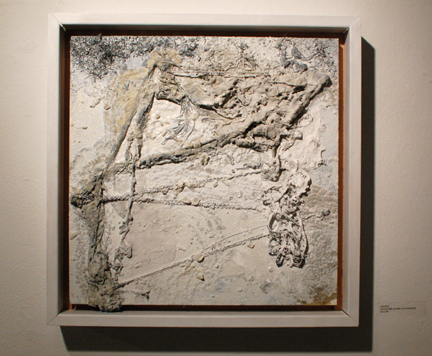
"Attached" Kimber Shiroma 2007
Shiroma's photographic exploration catapults the viewer into outer space, once again exploiting materiality to a completely different effect. The landscapes and abstractions seem microscopic images of plasma and the landscapes of the moon, expanding her mystical repertoire further.
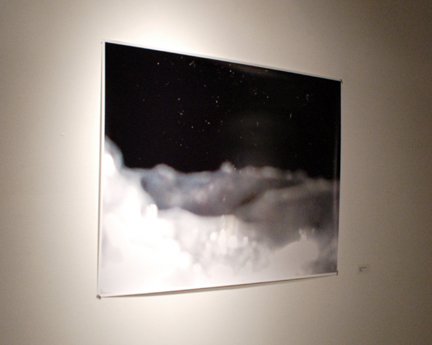
"White Landscape #2" Kimber Shiroma 2007
As photographs, they are not too precious to become cold or handless, yet float in the gallery space with an eerie otherworldliness. In this way, they directly relate and speak formally to the large works. While Shiroma clearly delves into similar subject matter throughout this work, and the diversity and variety she employs to do this is laudable, it almost seems as if these works could be endless bodies unto themselves. Placing them in conjunction with one another stretches the mental spaces and possibilities of this new vocabulary. In her attempts to test the distances of her materials, she breaches outer space and film, the innards of vast histories, and the edges of archeology.
Having recently been in front of one of Robert Motherwell's Elegy to the Spanish Republic paintings, I was struck with the power of these large works. I have no doubt Ms. Shiroma would have felt wonderfully at home in 1950's New York, smoking cigarettes with the boys; and Iempathize with her plight of being an abstract expressionist in a po-mo world. Hopefully, thoughful viewers will recognize that there is still much to be said on this front, especially by women. Their relevancy comes from the complex range of materials she uses to create a textural battlefield that draws in the viewer. They so fill this small, underground space, that I swear you can feel the walls bulging.
























![[TypeKey Profile Page]](http://www.portlandart.net/nav-commenters.gif)